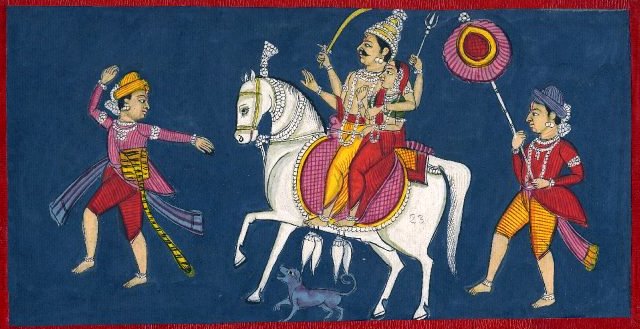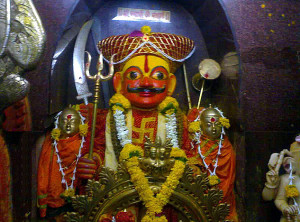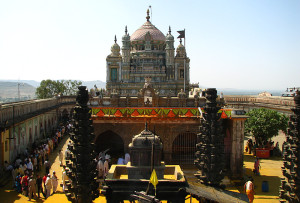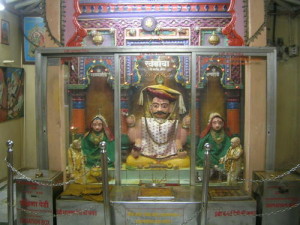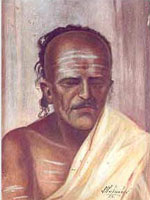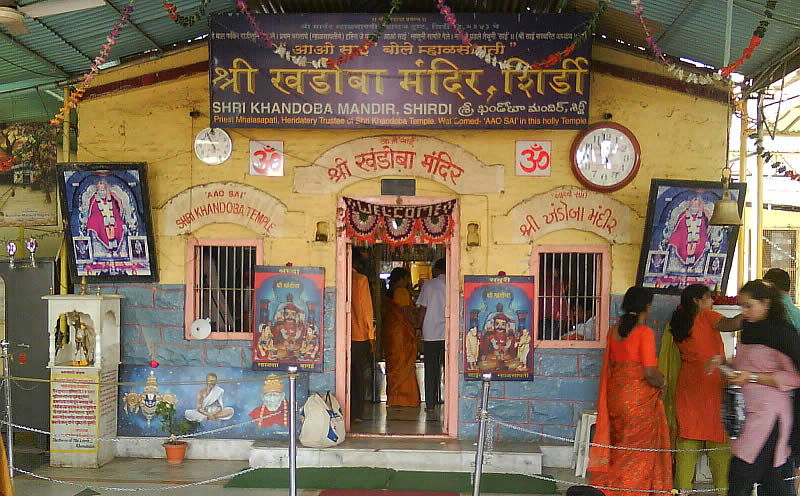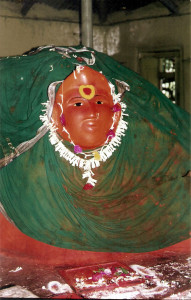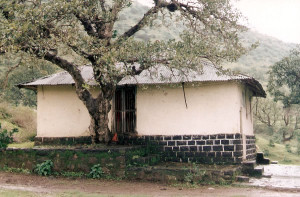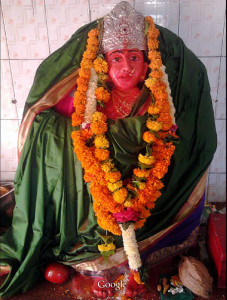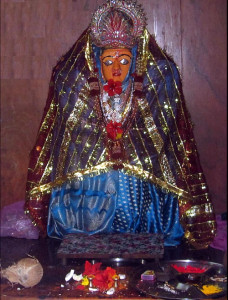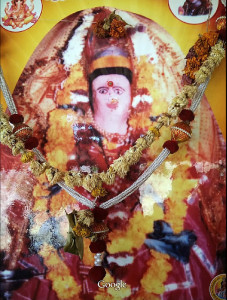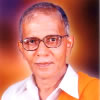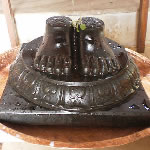Other temples in Maharashtra
There are other temples to Shri Mahalasa in Maharashtra, some of which are listed here. The stories that go with some of these are fascinating, to say the least.
The first is her famous temple at Jejuri near Pune where She is present along with Her consort, Lord Khandoba, an incarnation of Lord Shiva.
Shri Mahalasa is also present at Trimbakeshwar near Nashik and at a smaller and humbler temple at Shirdi, the pilgrim centre famous for Saibaba’s samadhi.
Other temples are known to exist in Nandurbar, Dhule, Nashik, Nandura, Bhogawati, Paithan and Waalseng. We will try and get information wherever and whenever possible.
With Lord Khandoba at Jejuri
Shri Mahalasa’s story here is incomplete without the story of Lord Khandoba. Lord Khandoba is worshipped in Jejuri, near Pune, here as Martand Bhairava, a form of Lord Shiva, and is also known by the following names: Khanderao, Khanderaya, Malhari, Martand, Ravalnath, Yelkoti Mahadev. Lord Khandoba is also known as Shri Mahalasakant — husband of Shri Mahalasa.
He is the most popular family deity in Maharashtra, the patron deity of Deshastha Brahmins, warrior, farming and herding castes, the hunters and gatherers of the hills and forests. Lord Khandoba is also worshipped by Dhangars, the oldest of tribes in the state.
The cult of Lord Khandoba (Khanda means sword, ba means father) has linkages with Vaishnava and Jain traditions, and also assimilates all communities irrespective of caste, including Muslims. Lord Khandoba is sometimes identified with Mallanna of Andhra Pradesh and Mailara of Karnataka. The legends of Lord Khandoba, found in the text Malhari Mahatmya and also narrated in folk songs, revolve around his victory over demons Mani-Malla and his marriages to Shri Mahalasa and many others.
The temple of Shri Mahalasa-Lord Khandoba is situated on a small hill, which can be seen while approaching the road. Visitors have to climb almost 200 steps to reach temple. The wonderful view of Jejuri town makes the journey to the temple marvellous. Although the temple is small, but it still looks beautiful with two divisions, Mandap and Gabhara.
Depiction
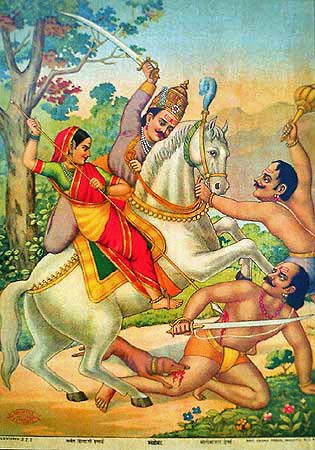
Lord Khandoba and Shri Mahalasa killing demons Mani-Malla. Lithograph by Chitrashala Press, Poona. Photos courtesy: Wikipedia Commons
In paintings and other pictorial depictions, Shri Mahalasa is seated in front of Lord Khandoba on his white horse. Shri Mahalasa is seen piercing a demon’s chest with a spear, while a dog is biting his thigh and the horse is hitting his head. The other demon is grabbing the reins of the horse and attacking Lord Khandoba with a club as the Lord is dismounting the horse and attacking the demon with his sword. In other representations, Lord Khandoba is seen seated on a horse with the heads of demons trod under the horse’s hooves or their heads under his knees.
In idols, Lord Khandoba or Lord Mailara is depicted as having four arms, carrying a damaru (drum), Trishula (trident), Bhandara-patra (turmeric powder-filled bowl) and khadga (sword).
Lord Khandoba is also worshipped as the aniconic Lingam, the symbol of Lord Shiva.
Khandoba is believed to be a manifestation of the Rudra form of Hindu God Shiva. The Khandoba history indicates that the deity had it origin in South India. The origin and story of Khandoba is found in the ‘Malhari Mahatmya’. The story suggests that Khandoba appeared to annihilate demons Mani and Malla and restore Dharma.
Legend has it that Mani and Malla became powerful by performing intense tapas (austerities) dedicated to Brahma. After several years Brahma gave them boons. With unimaginable power at their disposal, Mani and Malla started harassing saints, daivas (demi-gods) and humans. They created havoc and disturbed the peaceful life on earth and heaven.
Manichurna Mountain, the abode of several holy persons, was captured by Mani and Malla. Unable to tolerate their violence, saints, humans and demigods approached Lord Shiva who, in turn, brought out several lieutenants from his matted lock to fight the two demons and went to Manichurna Mountain. He himself took the form of Bhairav, the terrible form of Shiva, and Parvati took the form of Shri Mahalasa. In some regions, Shri Mahalasa is believed to be an incarnation of Mohini.
Shri Mahalasa and Shri Banai are the two consorts of Lord Khandoba. A horse or a bull is the vahana or vehicle of Lord Khandoba and dogs surround him. There is also a belief that the Bull is Nandi and he takes the form of a horse.
Jejuri being close to Pune , is easily accessible by all means of transport. There is an airport and railway station at Pune. Pune is well connected by road with all the major cities of state and other parts of the country. Tourists can also hire taxis from Pune. Visitors can also take buses from Sholapur.
The Shirdi Saibaba Connection
The temple of Lord Khandoba and his two consorts, including Shri Mahalasa, is known to almost all those who have visited Shirdi.
Sai Baba had first landed in Shirdi in the front of this temple, where its priest was the first person to welcome him saying, “Aao Sai”.
The priest of the temple belonged to a family of devotees of Shri Mahalasa and hence his name was Mahalasapati.
Incidentally, the simple temple is said to aruond 500 centuries old, but not much work has been done for its expansion.
Triyambakeshwar
Shri Mahalasa Devi’s Temple is situated behind the famous Adya Jyoritlinga temple at Triyambakeshwar, which is 28 km from Nashik.
The idol is more like a mound emerging out of the ground within the temple premises. The temple itself is a simple, understated construction.
Dhule, Nandurbar & Nashik
There are quite a few temples dedicated to Shri Mahalasa Narayani in Nandurbar, Dhule and Nashik districts, apart from the ones at Triyambakeshwar and Shirdi.
SOme of them are (click on them to see Google Map):
- Mahalasa Devi Temple aka Mhalsa Bhawani Mata at Arthe Bk in Shirpur, district Dhule.
- Mahalasa Mohini Kuladevata Temple, Chichkhede, district Dhule, near Panzara River.
- Kulswamini Shri Mahalasa Devi Mandir, Chandanpuri, Malgaon, district Nashik.
- Shri Mahalasa Devi Mandir, Pimpalwad Mhalsa, Chalisgaon-Malegaon Road, Chalisgaon, near Girna River. Varkhede Bk., district Nashik Maharashtra


